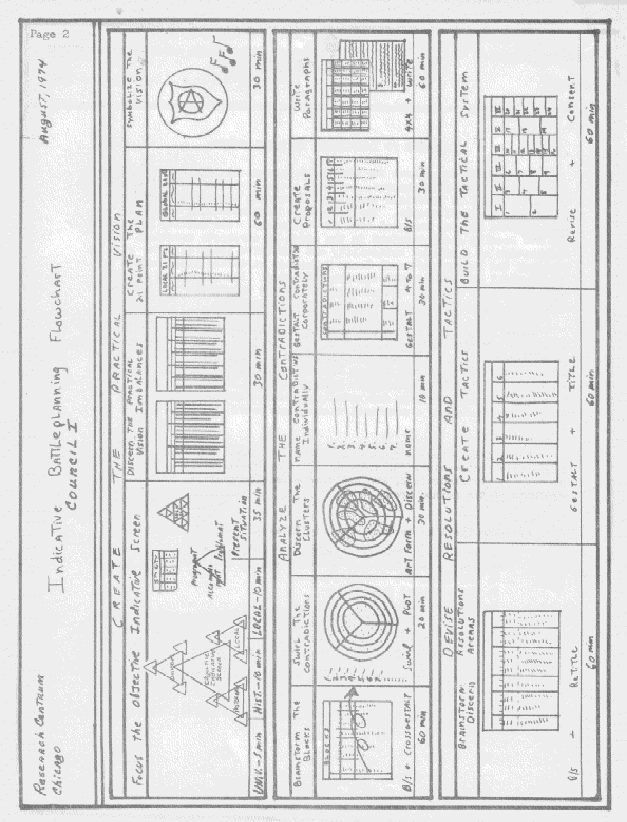
RESEARCH CENTRUM
Chicago
August, 1974
CONTENTS
Page
Preface . . . . . . . . . . . . . . . . . . . . . . . . . . . . . . . . . . . . . . . . . . . 1
Master Flowcharts . . . . . . . . . . . . . . . . . . . . . . . . . . . . . . . . . . 2-3
Objective Indicative Screens . . . . . . . . . . . . . . . . . . . . . . . . . . 4,5
21Point Plan . . . . . . . . . . . . . . . . . . . . . . . . . . . . . . . . . . . . . . 6
Procedures:
The Practical Vision . . . . . . . . . . . . . . . . . . . . . . . . . . . . . . . . . 7.8
Contradiction Analysis . . . . . . . . . . . . . . . . . . . . . . . . . . . . . . . 9
Proposals . . . . . . . . . . . . . . . . . . . . . . . . . . . . . . . . . . . . . . . . . . 10
Resolutions . . . . . . . . . . . . . . . . . . . . . . . . . . . . . . . . . . . . . . . . 11
Tactical System . . . . . . . . . . . . . . . . . . . . . . . . . . . . . . . . . . . . . . 11
Tactics Intent . . . . . . . . . . . . . . . . . . . . . . . . . . . . . . . . . . . . . . . .12,13
Implementaries . . . . . . . . . . . . . . . . . . . . . . . . . . . . . . . . . . . . . . . 14
Quarterly Battleplan . . . . . . . . . . . . . . . . . . . . . . . . . . . . . . . . . . .15
Weekly Modification . . . . . . . . . . . . . . . . . . . . . . . . . . . . . . . . . . 16,17
Warboard . . . . . . . . . . . . . . . . . . . . . . . . . . . . . . . . . . . . . . . . . . . 18
Instruments Formats . . . . . . . . . . . . . . . . . . . . . . . . . . . . . . . . . . 19
Page 1
RESEARCH CENTRUM INDICATIVE BATTLEPLANNING MANUAL
Chicago August, 1974
The concretion of love for the world, moving on many
fronts in creating the new forms of humanness, requires a common
method of tactical thinking and finesse of practical tools in
a form most useable in myriads of situations by local people.
The Indicative Battleplanning Method is the edge of this type
of tactical care for the world. Its quality is dynamic and its
results are determined in the midst of corporate creation. Its
combination of practical rationality and intuitive leaps call
for risk in deciding the future and break loose humanness at depths
not possible by teleological methods or goal centered thinking.
Its process of dealing comprehensively with the actual situation
gives permission for positive action by any group thus willing
to expend themselves.
These tactical thinking and problemsolving
methods, birthed in Fifth City as a concrete social sign, stimulated
great interest and sparked the formulation of Areas, Metros and
Cadres around the globe. Four years of actualization in The Local
Church Experiment clarified the use of tactics in a tactical system.
Subsequent analysis of the social process in its dynamical interrelatedness
and underlying contradictions, along with the means of articulating
a practical vision, now prove to be the key to the future.
Thus, this manual outlines procedures which allow
a local group to assess its sociosituation, articulate its
practical vision, discern the underlying contradictions, and build
an effective tactical system. The products of the method ARE:
I. The Tactical System, which includes
A. Title page with the symbol of the Quarter's thrust.
B. The Global and Local 21 Point Plans.
C. The Inclusive Contradictions
D. The Proposal Paragraphs
E. The Tactical System Chart
F. The Tactics with paragraphs of Intent and Implementaries
G. The Quarterly Calendar Timeline of Tactical Actualization
II. The Quarterly Warboard (described in the Appendix)
III. Instruments for Weekly Modification and Actualization
of the Tactics
 |
 |
|
|
UNIVERSAL The Universal screens hold the primal
story of selfhood and the world.
HISTORICAL The Historical screens hold the
accumulation of movemental wisdom.
LOCAL The Local screens hold the particularities
and uniquenesses of the immediate operating context,
Established Established Directions refers to the articulated consensus
Directions relative to the Movement's thrust in history.
Operating Principles are the foundational presuppositions
and definitudes which underlie all missional engagement, for example
the 5th City Presuppositions and the social ideology of "All
the earth belongs to all the people."
Operating Guidelines give practical direction to
the Movement's activity, for example the 9 Pressure Points, the
9 Whistle Points and the Global Program Consensus.
Operating Structures are the concrete forms which
give shape to the functioning dynamics of the Movement, for example
the Religious House, the Daily Office and the yearly time design.
Current - Current Trends are indicators of changes
in the social fabric of the local Trends situation.
Universal Trends are local manifestations of broader
global trends, such as the indictment of a city mayor as a manifestation
of political corruption.
Local Trends are societal trends unique to the immediate
context such as a trend toward storefront rehabilitation in a
business district.
Internal Trends are movemental, such as an increase
in Phase IV interns.
Present Present Situation is a description of the past year in
Situation light of the present moment and immediate
context.
A Progromat is a brief report of last year's activities.
An Accomplomat is an extensive report of the wondrous
happenings of the past year.
A Problomat is a brief objective intuitive list of
current issues with which we would like to deal.
 |
1. The 21Point Plan is an articulation of practical
vision which serves as a concrete model of operation for the year,
Everyone has a practical vision of what is going on in life and
how to participate. The Movement's task is to bring objectivity,
comprehensiveness and symbolization to that practical vision.
2. The 21Point Plan is a plan for the globe as visualized and responded to through a specific geographic area. The 21Point Plan is the first step of the Indicative Battleplanning process. This step is not an ironclad rational exercise but rather a short and intuitive exercise which articulates and holds the practical vision relative to the tasks of the coming year.
3. In deciding the number of points, such as 21,
an arbitrary number is chosen, holding complexity and basic irrationality,
In considering all the myriad issues of our time, the 21Point
Plan transforms those issues into one common missional thrust.
Finally, any one of 21 specific actions stands on its own and
is not necessarily sequentially related to the others.
CHART GOES HERE not scanned
| FOCUS
THE OBJECTIVE INDICATIVE SCREEN | 1. Context Practical Vision as both the rational and intuitive grasp of what is needed for the year ahead. Refer to the two Tactical Systems (Congregational and Parish) as screens to stimulate comprehensive thinking.
2. Briefly review the Universal, Historical and Local poles of the Objective Indicative Screen triangle and ground each in the group's experience. e.g., Universals Sociality the Social Process triangles Anthropology RSI/LENS; Mythology The Other World. 3. Spend most of the time on the Present Situation pole. Ask each individual to brainstorms 5 Local Happenings (Progromat) 10 Magnificent Accomplishments (Accomplomat) 3 Persistent Issues (Problomat) Have several people read their list and allow others to make additions. (Keep the movement lively and the mood light.) 4. Relate the brainstormed list to categories on the 5th City Social Model and the Local Church triangles. . |
| DISCERN
THE PRACTICAL VISION IMBALANCES | 5. Look at the rational charts of the Congregational and Parish Tactical Systems. Artform quickly and note the respective positions of the Cadre, Congregation and Parish on each. Discuss the valences of the tactics.
6. Ground the tactics in the local situation by having the group name activities and events that have happened in each tactic. Keep a running tabulation of the numbers and use to discern the imbalances in effective tactical actualization. Name the most "turned on" tactics. Name the least "turned on" tactics. 7. Shade in the imbalances on the charts. |
| CREATE
THE 21 POINT STRATEGY | 8. Brainstorm the Local 21 Point Plan. Allow the group 10 minutes for making lists of 21 points based on what is seen as necessary to rebalance the Local Church dynamic.
9. Break into subgroups of 5 to 7 for 20 minutes to pull together results of individual work into 21 points for the sub-groups. Record on newsprint or butcher paper for reporting.
10. Regather the subgroups and post the gestalted lists before the whole group. Do an intuitive gestalt of all the data into a 21 point Plan.
11. Compare the Local 21 Point Plan with the Global 21 Point Plan, noting similarities and differences and making any additions or revisions necessary.
12. Cluster the 21 Points into 4 to 7 Missional Arenas. Give each arena a title, write a sentence and create a poetic image for it. |
| SYMBOLIZE
THE VISION | 13. Celebrate the newly created Practical Vision with a song, ritual or other symbolic act.
14. Brainstorm the visual images inherent in the 21 points and assign 3 to 5 persons to design a Practical Vision symbol for the Warboard and front cover of the Tactical System. Assign another 3 to 5 persons to write a song for the quarter. Assign others to make necessary preparations for the next session, including printing or duplicating the 21 Point Plan and other forms needed for Contradiction Analysis and workshopping Proposals and Tactics.
(Note: When printing, sufficient copies need to be done for compilation into the Local Tactical System.)
15. Conclude the session with the whole group gathered to see the symbol, sing the song and be sent out. |
BRAINSTORM SWIRL AND NAME AND BRAINSTORM GESTALT TO
THE BLOCKS CLUSTER THE GESTALT THE PROPOSED PROPOSALS AND
PRECONTRADICTIONS CONTRADICTIONS ACTIONS WRITE PARAGRAPHS
| BRAINSTORM
THE BLOCKS | 1. Individually brainstorm at least 3 blocks for each arena of the 21 Point Plan. Move quickly on this.
2. Have each participant star the most critical block in each arena. List the starred blocks on the chalkboard. Ask the group to scan the list and add blocks previously omitted. 3. Crossgestalt to about 20 precontradictions and discern intuitively the 3 5 precontradiction arenas. 4. Introduce a "discontinuous moment" into the group, like a song. |
| SWIRL
THE PRE - CONTRADICTIONS | 5. Draw a large swirl chart with four concentric circles. Divide it into as many sections as there are precontradiction arenas and write the title of each around the outer circle periphery.
6. Plot all the precontradictions on the swirl in two word holding phrases, locating each in the appropriate section with the more critical ones near the center and to one side or another as the group intuits, |
| DISCERN THE
CLUSTERS | 7. Artform the plotted data, looking for relationships and patterns. Discern and encircle 5 11 contradiction clusters. |
| NAME
INDIVIDUALLY | 8. Individually name the contradiction underlying each cluster. |
| GESTALT
CONTRADICTIONS CORPORATELY | 9. Corporately gestalt the contradictions named above into 4 7 inclusive contradictions. 10. Insert a "change of pace" such as singing a song. |
| CREATE
PROPOSALS AND WRITE PARAGRAPHS | 11. Individually brainstorm at least three proposed actions relative to each contradiction. Move quickly on this.
12. Ask each participant to star the most significant item in each column. List the starred items on the board. Ask the group to scan the list and add their previously omitted data or new insights,
13. Divide into subgroups of 3 or more and assign the lists of proposed actions. Instruct the subgroups to gestalt the lists to titles which represent the proposals and expand each proposal to four points. Retitle the column and put the data on the board.
14. Reconvene for brief reports and reflection. Consense on the Proposals and reassign them to the groups for writing paragraphs.
15. Arrange to have the paragraphs duplicated before the next cession |
 |
| BRAINSTORM
RESOLUTIONS AND DISCERN ARENAS | |
| CREATE
TACTICS | |
| BUILD
THE TACTICAL SYSTEM |
1. Reed the proposa1 paragraphs from the last session
and do a brief artform on the data behind them,
2. Individually brainstorm at least three resolutions
that will actualize each proposal. List these on the board and
look across the whole for relationships and insights previously
unseen.
3. Erase the column titles and scan the whole to
discern the 4 to 6 tactical arenas. Cross gestalt the data into
the arenas and give each arena a title.
4. Divide into subgroups of 3 or more and assign
the tactical arenas.
5. In subgroups, gestalt each tactical arena list
into 2 to 7 tactics. Give each tactic a concrete three word title.
6. Reconvene for reports and reflection. Create a
Tactical System chart on the board out of the work of the subgroups.
7. Study the chart carefully and compare it with
the imbalances done on the Rational Charts in Session 1. Revise
and polish the tactics as necessary.
8. Celebrate the work of Council I.
9. Make assignments necessary for printing and preparation for Council II.
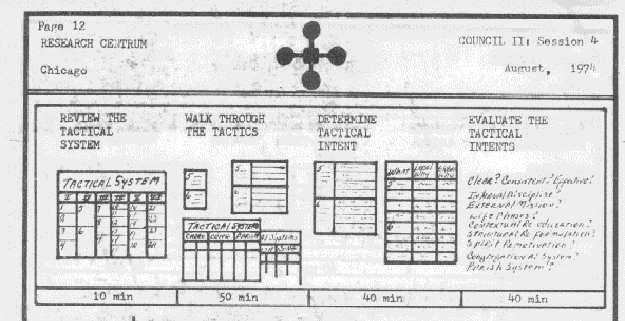 |
|
| REVIEW
THE TACTICAL SYSTEM | 1. Distribute the Tactical System created at Council I and give a brief overview of the arenas and tactics. 2. Display and call attention to the new Warboard. Note the calendar, tactical system and quarterly symbol on it and context the task of this Council to create Implementaries and fill in the tactical activities of the 13 weeks. |
| WALK
THROUGH THE TACTICS | 3. Walk through each tactic of the system, recovering common memory of the data from which they were created. Advise everyone to take careful notes for use in further work on the tactics. 4. For each tactic, brainstorm the "What's" that will accomplish its thrust. Try for four or more. Ask, "Where do you see this tactic already going on ?"
Check the Congregational and Parish Tactical Systems for effective resource data and comprehensiveness. 5. Divide into subgroups and assign the tactics. |
| DETERMINE
TACTICAL INTENT | 6. In subgroups discern 4 to 6 What's for each tactic. Resources of the Congregational and Parish Tactical Systems are crucial.
7. For each What, clearly state Why it is needed globally/locally.
8. For each tactic, write a paragraph of about 50 words stating the tactical intent by defining the What's and delineating the Why's in relation to the local situation and global context. 9. Create charts of the What's and Why's to post before the whole group during the reporting session. |
| CHECK
THE TACTICAL
INTENTS | 10. Reconvene for reports, reflection and consensus. As reports are given, ask the group to look for clarity, consistency and effectiveness. Allow for discussion, if needed. 11. In reflection on the tactics as a whole, asks Will our tactical system actualize the Local Church Tactics ? What tactics deal with internal discipline ? external mission ? What are the emphases of the tactics relative to life phases ? There do you see contextual reeducation called for ? structural reformulation ? spirit remotivation ?
Have we omitted Local Church Tactics ? What is our rationale ? 12. After consensus, assign forces necessary to prepare a ditto master for each tactic, as illustrated on the Preparation for Council II page of this manual. Record the consensed on paragraphs and the What's and Why's. Duplicate just enough copies for those present or expected in the next session. Save the carbon sheets and the remainder of the ditto master for completing other categories in Session 5. |
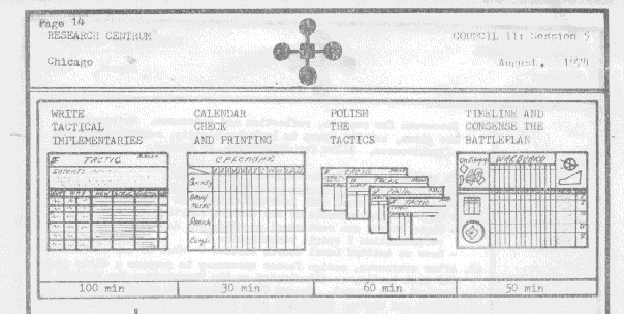 |
| WRITE
TACTICAL IMPLEMENTARIES | 1. Context effectiveness in parish renewal as the power of a common thrust, The project is about the task of empowering the total Local Church dynamic in the community, It is one mission in multiple locations, effected by creating and actualizing corporate tactics.
2. Divide into subgroups of 3 or more and assign the tactics. Distribute the partially complete dittoed tactics to be used as worksheets.
3. In subgroups, briefly brainstorm a list of "How's" for each What. Select two or three most effective or suitable and record.
4. Do the same procedure for "Structures." Structures indicate the social arena in which the tactic is to be actualized.
5. Do the same procedure for "Forces." Strategic and helpful use of forges includes, in addition to the present body, all colleagues such as other guildsmen, historical churchmen, metro movement, religious house, etc.
6. After finishing each tactic, review the whole and decide on the tentative week actualization would be best for each of the 4 or more What's. 7. Exchange tactics with another subgroup to check for clear wording and effective implementation. |
| CALENDAR
CHECK AND PRINTING | 8. After completing the tactics, check the suggested weeks of implementation against the common calendar ofsocietal, movemental, community and congregational events. Make changes as required by the calendar. If the calendar reveals additional possibilities, modify the tactics with other What's.
9. Assign someone from the subgroup to complete the partially used ditto master with the data from this session and duplicate the completed tactics for the whole group. (At this point, these editions of the tactics are "worksheets" for reporting to the whole group.) 10. Assign others from the subgroup to make small, moveable tabs of each. What and place them on the common flow chart for final tactical timelining by the whole group. |
| POLISH
THE TACTICS | 11. Reconvene with a spiritizer such as a song, ritual or reading.
12. Distribute the completed tactics worksheets to all and allow each subgroup to report on its tactics. As reports are given, instruct the group to listen for key insights, highly imaginal implementaries and structures to be effected. 13. Quickly walk through the tactics and briefly discusses clarity, practicality and feasibility. the relationship of the tactics to the Practical Vision. how the tactics embody the 21 Point Plan. how the tactics effectively deal with the Contradictions. any necessary changes. |
| TIMELINE
THE TACTICS | 14. Direct attention to the quarterly flowchart and discuss:
what do you note about the flow ? sequence ? where are weeks heavy ? light ? empty 7
are there shifts to be made ? 15. Adjust the what tabs on the flowchart and note changes on the tactics worksheets. |
| CONSENSE
ON THS BATTLEPLAN | 16. Artform the corporate thrust of the coming quarters
what are to be the quarter's gifts ? what dangers do we need to watch for ? what insights do we need to remember ? what are some implications about forces ? what do you see that you didn't know you knew before ? 17. Consense and celebrate the common direction and new battleplan. 18. Make assignments necessary to print corrected tactics and the Quarterly Calendar and to complete the Warboard. |
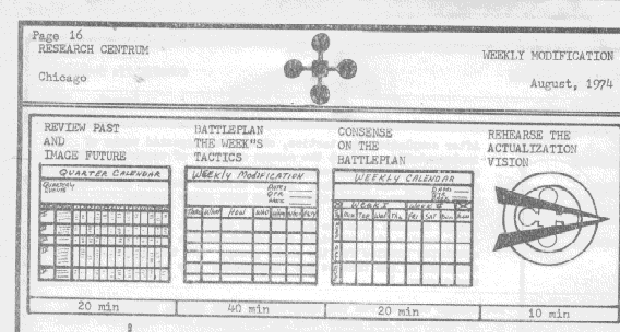 |
|
| REVIEW
LAST WEEK'S ACTIVITY | Weekly modification in Indicative Battleplanning continues to emphasize the power of the corporate thrust. These procedures are therefore intended to be followed by the total group except in certain exceptional cases as noted below. 1. Display the Warboard where the whole group can see it and give a brief context on the Quarter's Battleplan, Rehearse the tactics for the past week and call for reports on actualization. 2. Quickly art form the results of the past week's activity. What were the gifts ? Where were the tactics blocked ? What are the implications for the future ? 2. What revisions of the tactical system are necessary ? 3. Pronounce absolution on the past week's work. |
| IMAGE
THE COMING WEEK | 4. Rehearse the tactics for the coming week. (Weekly Modification Sheets as illustrated on the Instruments pages serve as a helpful tool.)
5. Briefly share corporate insights of possibilities for actualization, 6. Cluster the tactics for battleplanning in subgroups. Divide the group into subgroups of two or more for building battleplans and assign the tactics, |
| BATTLEMAN
THE WEEK'S TACTICS | 7. Disperse into sub-groups and do the following for each tactic.
Review the Intent Paragraph and Implementaries Chart. Brainstorm and consense on the particular What, Why, How, who, Where, and When Be prepared to state briefly the focus of the battleplan and how It will actualize the intent of the tactic. |
| CONSENSE
ON THE BATTLEPIAN | 8. Reconvene as a total group and report on the plans for actualizing the tactics. 9. Use the Weekly Battleplan Calendar (illustrated on the Instruments page) to coordinate and revise the Timeline and Assignments Note: Some Auxiliaries, Cores and Metro Cadres may need addition time in this session or another occasion for implementing tactics in particular congregations or situations. |
| REHEARSE
THE ACTUALIZATION VISION | 10. Rehearse the Actualization Visions Artform the coming week's activity. - Select an image or story to hold the tactical thrust. - - Identify the focus of the week. - Ritualize the consensus for action. |
The Warboard is an essential means of symbolizing
the context and thrust of the Quarterly Battleplan. Holding the
Global and Local, the theoretical and practical, the artistic
and the actual, the rational and sequential, it sets forth the
strategies and tactics by which the decision to win is held before
the group. As a practical tool, it serves as both reminder of
accountability and key to envisioning the concrete steps to be
taken in the future.
The Calendar is composed of societal, community,
movemental and congregationa1 events crucial to the missional
thrust. Care needs to be exercised especially at the point of
including the locally modified 26/52 Week Timelines and the other
movemental events scheduled during the quarter. Preparation of
the Calendar must be done before the Council for building the
:Implementaries of the Tactical System.
With emphasis on the corporate thrust, only one warboard
is necessary for the whole body, Cards for weekly Implementaries
may be used or they may be printed directly on the board itself.
Use of color coding for the tactics is a further means of dramatizing
weekly and quarterly actualization.
To make the Warboard an adequate visual tool requires
it to be large enough to be seen by the total group and displayed
at the weekly meetings. To make it portable requires collapsible
sections of lightweight material.
 |
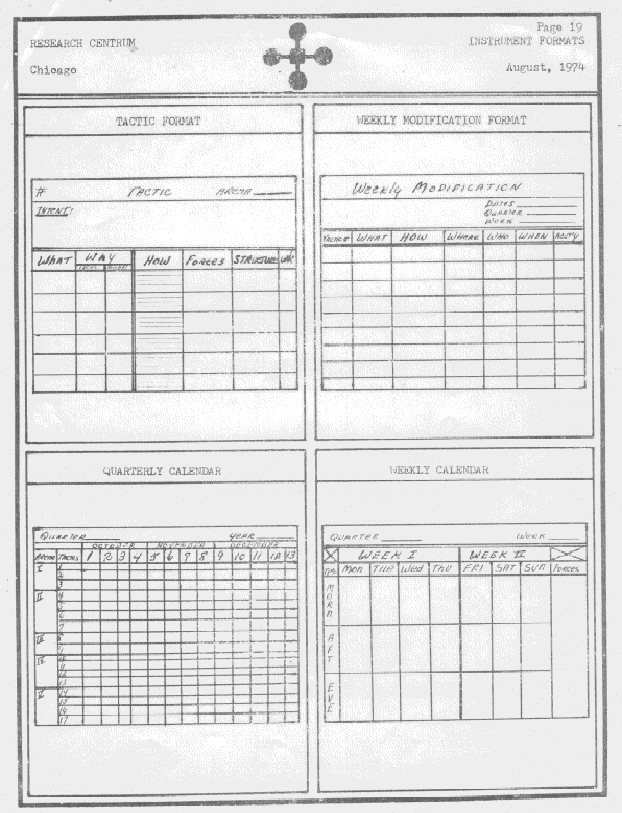 |